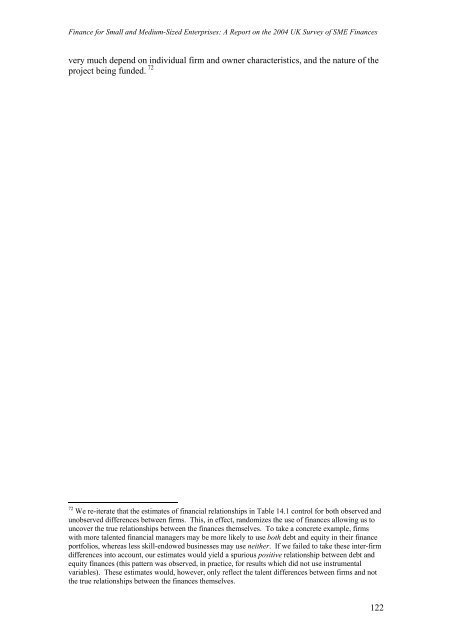Finance for Small and Medium-Sized Enterprises - DTI Home Page
Finance for Small and Medium-Sized Enterprises - DTI Home Page
Finance for Small and Medium-Sized Enterprises - DTI Home Page
Create successful ePaper yourself
Turn your PDF publications into a flip-book with our unique Google optimized e-Paper software.
<strong>Finance</strong> <strong>for</strong> <strong>Small</strong> <strong>and</strong> <strong>Medium</strong>-<strong>Sized</strong> <strong>Enterprises</strong>: A Report on the 2004 UK Survey of SME <strong>Finance</strong>s<br />
very much depend on individual firm <strong>and</strong> owner characteristics, <strong>and</strong> the nature of the<br />
project being funded. 72<br />
72 We re-iterate that the estimates of financial relationships in Table 14.1 control <strong>for</strong> both observed <strong>and</strong><br />
unobserved differences between firms. This, in effect, r<strong>and</strong>omizes the use of finances allowing us to<br />
uncover the true relationships between the finances themselves. To take a concrete example, firms<br />
with more talented financial managers may be more likely to use both debt <strong>and</strong> equity in their finance<br />
portfolios, whereas less skill-endowed businesses may use neither. If we failed to take these inter-firm<br />
differences into account, our estimates would yield a spurious positive relationship between debt <strong>and</strong><br />
equity finances (this pattern was observed, in practice, <strong>for</strong> results which did not use instrumental<br />
variables). These estimates would, however, only reflect the talent differences between firms <strong>and</strong> not<br />
the true relationships between the finances themselves.<br />
122















![Joint Report on Social Protection and Social Inclusion [2005]](https://img.yumpu.com/19580638/1/190x132/joint-report-on-social-protection-and-social-inclusion-2005.jpg?quality=85)
